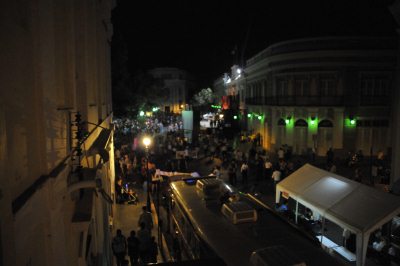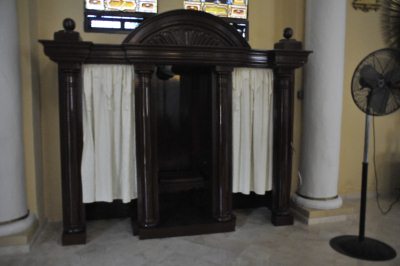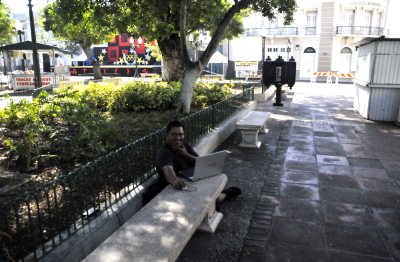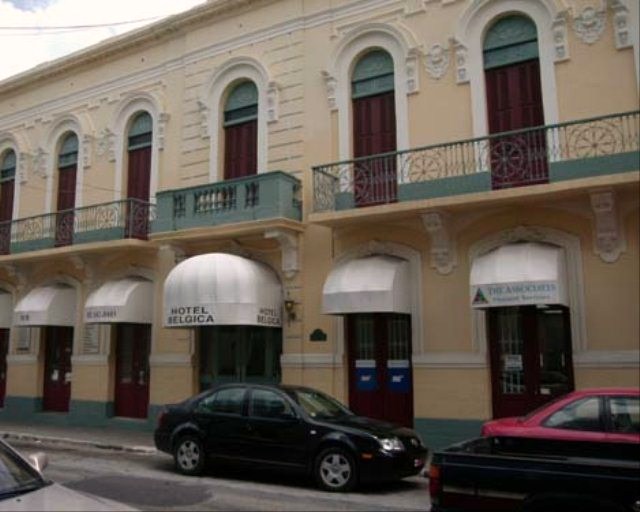Ponce

|
Ponce
 After our smashing morning, we left Mimi's and headed toward Ponce, after stopping for lunch, we came to a road block just before two, as it was carnival - own blog. All we could do was enjoy the afternoon, we finally saw our hotel at just shy of eight.
How we first saw the Plaza, the judging for the carnival was so close, all was quiet by midnight. The next morning, Bank Holiday Monday In the early 1800’s, Ponce - pronounced Pon-say, continued to be one of dozens of hamlets that dotted the Island. Its inhabitants survived by subsistence agriculture, cattle raising and maritime contraband with foreigners. However, in the 1820's, three events took place that would dramatically changed the size of the town forever. The first of these events was the arrival of a significant number of French citizens, fleeing the Haitian Revolution that dragged on between 1792-1804. The effect of this mass migration was not felt significantly until the 1820's. These French entrepreneurs were attracted to the area because of its large flatlands and came with enough capital, slaves, and commercial connections to make a significant impact in Ponce's sugar cane production. The second event was the arrival of landlords and merchants from Latin American countries (and in particular from Venezuela) resulting from the deterioration of the Spanish Empire in Central and South America when those countries gained their independence from Spain in the 1810's - 1820's. The third event was the declaration of the Spanish Royal Decree of Graces of 1815, which allowed any citizen of a country politically friendly to Spain to settle in Puerto Rico as long as they converted to the Catholic faith and agreed to work in the agricultural business. With such mass migrations, not only the size of the town was changed, but the character of its population was changed as well. On the 29th July 1848, and as a result of this explosive growth, the Ponce hamlet was declared a village by Queen Isabella II, and in 1877 the village obtained its city charter.
The gorgeous architecture The Royal Decree of Graces also brought a strong influx of immigrants from Europe, further strengthening its economy and assuring its progress. Immigrants came from regions like Catalonia, the Balearic Islands and other regions of eastern Spain, as well as from the United Kingdom, Germany and France. This was in addition to the wealthy Spaniards who fled from the independence revolts in Cuba, Colombia and Venezuela.  
In 1899, Ponce was ravaged by an enormous fire. The fire threatened to destroy much of the south coast, but thanks to the firemen of Ponce who operated from Parque de Bombas fire station, Ponce and the south were saved. The fire station in the central plaza has since become a museum and tourist attraction. The station continued serving the Ponce community until 1990, when it was turned into a firefighting history museum.
 
At the time of the US invasion and occupation of Puerto Rico in 1898 during the Spanish-American War, Ponce was the largest city in the island. With a population of some twenty two thousand, Ponce had the best road in Puerto Rico, built by the Spaniards for military purposes running from Ponce to San Juan. The taking of Ponce by American troops "was a critical turning point in the Puerto Rican campaign. For the first time the Americans held a major port to funnel large numbers of men and quantities of war material into the island. Ponce also had underwater telegraph cable connections with Jamaica and the West Indies, putting the US forces on the island in direct communication with Washington for the first time since the start of the campaign. Just prior to the US occupation of the Island, Ponce was a flourishing and dynamic city with twenty kilometres of streets in the urban core, thirty eight public buildings, four education centres, three hospitals, seven locations for public beneficence, a large number of industries and commercial firms and a great number of exquisite residences that reflected the high standing of Ponce's bourgeoisies. 
The Americans
disembarked at Playa de Ponce on the 27th of July via the Cincinnati, Dixie,
Wasp and Gloucester. Reinforcements
arrived next day, after marching from their landing at Guanica, under General
Miles, and the Americans took possession of the city. There were skirmishes in
the city, but no major battle was fought. On the Spanish side, three men were
killed and thirteen wounded, four Americans were wounded. The American flag
was raised in the town centre that same day and most of the Spanish troops
retreated into the surrounding mountains. The US Army then established its
headquarters in Ponce.
Period
of stagnation: After
the US invasion,
the Americans chose to centralise the administration of the island in San
Juan,
the capital, starting a period of socio-economic stagnation
for Ponce. This was worsened by several factors:
This
prompted the residents to initiate measures to attract economic activity back
into the city. Also, a solid manufacturing industry surged that still remains.
Examples of this are the Ponce Cement,
Puerto Rico Iron Works, Vassallo Industries and Destilerias
Serralles. Ponce massacre: On the 21st March 1937, a peaceful march organized by the Puerto Rican Nationalist Party to celebrate the 64th anniversary of the abolition of slavery turned into a bloody event when the Insular Police opened fire upon what a US Congressman and others reported were unarmed and defenseless cadets and bystanders, killing nineteen and badly wounding over two hundred more many in their backs while running away. An ACLU Report declared the event a massacre, and it has since been known as the Ponce Massacre. It is the largest massacre in Puerto Rican historyThe Mameyes
landslide: On
the 7th of October 1985, Ponce was the scene of a major tragedy, when
at least one hundred and twenty nine people lost their lives to a
mudslide
in a sector of Barrio Tibes
called Mameyes.
International help was needed to rescue people and recover corpses. The US and
many other countries, including Mexico, France and Venezuela,
sent economic, human and mechanical relief. The Commonwealth Government,
subsequently relocated hundreds of people to a new community built on stable
ground. In 2005, the National Science and Technology Council's Subcommittee on
Disaster Reduction of the US reported that the Mameyes landslide held the record
for having inflicted "the greatest loss of life by a single landslide" up to
that year.
Recent History: Ponce has improved its economy in the last years and has solidified its position as the second most important city of Puerto Rico based on its economic progress and increasing population.Architecture: |










